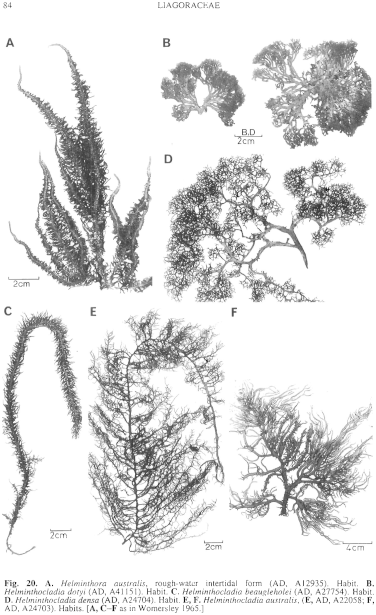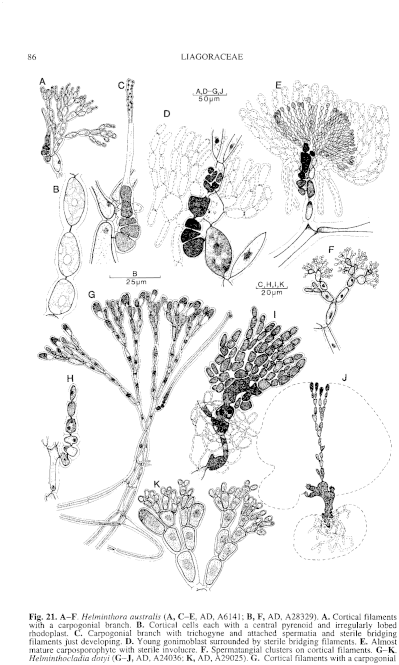|
|
|
|
|
|||||||||||
|
Electronic Flora of South Australia Species Fact Sheet
Phylum Rhodophyta – Class Florideophyceae – Order Nemaliales – Family Liagoraceae
Thallus (gametophyte) (Fig. 20B) brownish purple, 2–7 cm high, with one to several terete, much-branched, subdichotomous axes, often with short lateral or proliferous branches below; lower branches 1–3 mm in diameter, upper 0.5–1 mm in diameter. Holdfast discoid to pulvinate, 2–10 (–15) mm across, probably perennial; epilithic. Structure multiaxial, with a medulla of mostly slender filaments, intermixed with broader ones, and a cortex (Fig. 21G) usually 200–400 µm broad, consisting of slender filaments of elongate cells (mid cells fusiform with a central nucleus), subdichotomously branched every 1 (–3) cells, with the terminal cells slightly swollen, clavate to elongate-ovoid, (14–) 18–22 (–24) µm long by (4–) 6–8 µm in diameter.
Tetrasporophyte unknown.
Reproduction: Sexual thalli dioecious or occasionally monoecious. Carpogonial branches (Fig. 21G) 3 or 4-celled, curved, laterally situated on a cell below a bifurcation on the inner part of the cortical filaments; carpogonial branch (unfertilized?) often continuing growth into a vegetative filament (Fig. 21H); carpogonium elongate-conical. Zygote dividing obliquely with (usually) both cells dividing to form the gonimoblast; gonimoblast compact (Fig. 21I), lying within the cortex, 150–200 µm across in surface view, with terminal ovoid carposporangia 8–10 µm long by 4–8 µm in diameter. Pit-connections of carpogonial branch cells enlarging (Fig. 21I) following fertilization, ultimately forming a distinct fusion cell (Fig. 21J) involving also the supporting cell and lower cells of the gonimoblast filaments. Sterile post-fertilization filaments develop from the 2 cells surmounting the supporting cell (Fig. 21I), at about the time of the first zygote division, with other such filaments developing from the supporting cell and the cell below it, forming a tangled mass (Fig. 21J) around the supporting cell and old carpogonial branch, just below the developing carposporophyte; these cells soon lose their contents and the mass may later become relatively inconspicuous. Spermatangial clusters (Fig. 21K) digitate, forming spermatangia after several divisions of upper cortical cells.
Type from Lawrence Rock, Portland, Vic., in low rock pools (Beauglehole, 15.i.1960); in AD, A24036.
Selected specimens: Pennington Bay, Kangaroo I., S. Aust., lower eulittoral (Kraft & Min Thein, 1.xii.1971; AD, A41327). Cape Lannes, S. Aust., mid eulittoral (Womersley, 20.xii.1971; AD, A41151 -"Marine Algae of southern Australia" No. 69). Lawrence Rock, Vic., on reef edge (Beauglehole, 15.i.1960; AD, A24807). Sorrento, Vic., lower eulittoral (Ducker, 28.x.1963; AD, A29025). Leonard Bay, Wilsons Prom., Vic. (Price, 10.i.1963; AD, A29267). Bicheno, Tas., lower eulittoral (Womersley, 4.xi.1982; AD, A56453). Port Arthur, Tas., lower eulittoral (Cribb 114.4, 18.i.1951; AD, A16209).
Distribution: Pennington Bay, Kangaroo I., S. Aust., to Wilsons Prom., Vic., and SE Tasmania. Ulladulla and Look-at-me-now Headland, near Coffs Harbour, N.S.W. & Kraft 1993, p. 8).
Taxonomic notes: H. dotyi, present only during summer months, differs from other species of Helminthocladia in its habit in particular. No other Australian species, nor apparently those from elsewhere, has a massive base bearing several subdichotomous axes, sometimes proliferous below. The only possible confusion amongst Australian species is with Helminthora lindaueri, which has dichotomous axes but lacks the massive base, and also differs in reproductive details.
References:
WOMERSLEY, H.B.S. (1965). The Helminthocladiaceae (Rhodophyta) of southern Australia. Aust. J. Bot. 13, 451–487, Plates 1–7.
The Marine Benthic Flora of Southern Australia Part IIIA complete list of references.
Publication:
Womersley, H.B.S. (14 January, 1994)
The Marine Benthic Flora of Southern Australia
Rhodophyta. Part IIIA, Bangiophyceae and Florideophyceae (to Gigartinales)
Reproduced with permission from The Marine Benthic Flora of Southern Australia Part IIIA 1994, by H.B.S. Womersley. Australian Biological Resources Study, Canberra. Copyright Commonwealth of Australia.
Illustrations in Womersley Part IIIA, 1994: FIGS 20B, 21 G–K.

Figure 20 enlarge
Fig. 20. A. Helminthora australis, rough-water intertidal form (AD, Al2935). Habit. B. Helminthocladia dotyi (AD, A41151). Habit. C. Helminthocladia beaugleholei (AD, A27754). Habit. D. Helminthocladia densa (AD, A24704). Habit. E, F. Helminthocladia australis, (E, AD, A22058; F, AD, A24703). Habits. [A, C–F as in Womersley 1965.]

Figure 21 enlarge
Fig. 21. A–F. Helminthora australis (A, C–E, AD, A6141; B, F, AD, A28329). A. Cortical filaments with a carpogonial branch. B. Cortical cells each with a central pyrenoid and irregularly lobed rhodoplast. C. Carpogonial branch with trichogyne and attached spermatia and sterile bridging filaments just developing. D. Young gonimoblast surrounded by sterile bridging filaments. E. Almost mature carposporophyte with sterile involucre. F. Spermatangial clusters on cortical filaments. G–K. Helminthocladia dotyi (G–J, AD, A24036; K, AD, A29025). G. Cortical filaments with a carpogonial branch. H. Abnormal cortical filament originating from an unfertilized carpogonial branch. I. Semi-mature gonimoblast with basal fusion cell and irregular mass of sterile filaments. J. Outline of mature carposporophyte with fusion cell and basal mass of sterile filaments. K. Spermatangial clusters (in median view). [A, C–K after Womersley 1965.]

|
Email Contact: State Herbarium of South Australia |

|